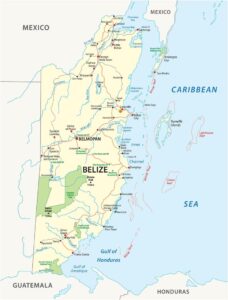Over the centuries, the territorial boundaries of Belize have been influenced by a complex and contentious historical narrative. You might wonder why the border between Belize and Guatemala appears as a dotted line on many maps; this graphic representation encapsulates a deeply entrenched territorial dispute. This ongoing conflict stems from historical claims made by Guatemala, which has persistently challenged Belize’s sovereignty since it achieved independence. The potential for international tensions remains considerable, as both nations actively pursue diplomatic avenues to address this boundary issue. Your investigation into this geopolitical conundrum unveils intricate challenges surrounding national borders in Central America, where colonial legacies and notions of territorial integrity intertwine in potentially explosive ways.
Diving Deeper into the Historical Claims Surrounding the Belize-Guatemala Dispute
The persistent territorial conflict between Belize and Guatemala can be traced back to intricate historical and colonial legacies. This dispute originates from the colonial period when territorial boundaries were frequently vaguely defined and open to subjective interpretation. The unresolved border issue has endured for centuries, resulting in ongoing tensions between these neighbouring nations and affecting their diplomatic relations significantly.

Unpacking Guatemala’s Long-standing Territorial Claims Over Belize
Guatemala has persistently asserted its historical claim to territorial rights over Belize, a position rooted in the Spanish colonial administrative boundaries. It may come as a surprise to learn that Guatemala regards Belize as part of its original territorial inheritance from the Spanish Empire, thus contesting the modern borders established during the British colonial period. This historical viewpoint continues to energise Guatemala’s claims and complicates the matter of sovereignty.
Assessing the Implications of Historical Borders on Current Relations
The undefined boundaries established since the colonial era have given rise to significant geopolitical challenges for both nations. The undefined border regions create opportunities for conflict and ongoing diplomatic tensions, which, in turn, impact local communities and national sovereignty. A thorough understanding of the border dispute reveals complex layers of historical, legal, and territorial dynamics. The implications of this conflict extend beyond mere geographical demarcations, encompassing economic, cultural, and security risks. The enduring conflict has significant repercussions for regional stability, international law, and the prospects for future negotiations between Belize and Guatemala.
The Importance of the Dotted Line on Maps in Representing Territorial Disputes
If you look closely at maps, you will notice a distinctive feature: a dotted boundary line between Belize and Guatemala, which signifies an unresolved territorial dispute that has lasted for decades. This unique cartographic representation encapsulates a complex geopolitical challenge, where the exact border remains undefined and contested. The dotted line serves as a symbol of the ongoing diplomatic tensions and the unresolved territorial claims that have characterised the relationship between these two Central American nations for an extended period.
Understanding International Recognition Amidst the Unresolved Border Dispute
Within the realm of international relations, Belize asserts itself as a sovereign state with an acknowledged international presence; however, the disputed border with Guatemala creates a nuanced geopolitical scenario. You may find it intriguing that while Belize gained independence in 1981, Guatemala has historically contested its territorial integrity. The dotted line not only signifies geographical ambiguity but also reflects an ongoing diplomatic negotiation that continually influences regional relations and global perceptions.
The Diplomatic Weight of the Dotted Line in International Relations
Beyond its cartographic function, the dotted line serves as a compelling diplomatic symbol. It can be interpreted as a visual representation of unresolved territorial claims, signalling to the international community the complex negotiations between Belize and Guatemala. This distinctive border marking conveys the ongoing dialogue and potential for a peaceful resolution to the conflict. However, the dotted line embodies more than just a geographical curiosity; it represents a delicate diplomatic instrument that helps avert potential military escalation while keeping open channels for negotiation.
This line functions as a strategic buffer, allowing both nations to maintain diplomatic relations and work towards a future resolution. Its existence demonstrates how international borders can be managed through peaceful dialogue, highlighting a sophisticated approach to territorial disputes that prioritises communication over conflict.

In-depth Analysis of Key Conflicts and Diplomatic Agreements Between Belize and Guatemala
The territorial disputes between Belize and Guatemala are steeped in history and characterised by complex diplomatic tensions and unresolved boundary claims. You will discover that the ongoing disagreement revolves around competing interpretations of colonial-era treaties and the concept of territorial sovereignty. This dispute carries far-reaching implications for both nations, involving potential land ownership challenges and regional geopolitical dynamics that continue to influence their relationship.
Examining the Impact of the 1859 Treaty and Subsequent Developments
Before the signing of the 1859 treaty between Britain and Guatemala, territorial boundaries within the region were often ambiguous and fiercely contested. It is essential to understand that this agreement aimed to establish clear borders; however, subsequent interpretations led to ongoing disputes. Guatemala consistently challenges the treaty’s validity, claiming that Britain failed to fulfil certain commitments regarding infrastructure development, which has become a pivotal point of contention in their territorial disagreement.
International Court of Justice Engagement and Recent Diplomatic Initiatives
Recent diplomatic efforts have focused on resolving the longstanding border dispute through international legal avenues. You will note that both nations have agreed to present their case to the International Court of Justice (ICJ) for a binding resolution. This approach marks a significant step towards peaceful conflict resolution and the possibility of normalising bilateral relations.
Alongside the ICJ proceedings, it is important to recognise the intricate diplomatic negotiations that have unfolded. The potential referendum in both countries to validate the ICJ’s decision represents a unique method for resolving territorial disputes. Your comprehension of this process highlights the delicate diplomatic efforts to uphold regional stability and resolve historical territorial claims through peaceful, internationally recognised mechanisms.
Current Situation and Travel Considerations for Visitors
Many travellers find themselves intrigued by Belize’s distinctive border configuration with Guatemala. The ongoing territorial dispute has produced a complex geopolitical landscape that affects travel and border crossings. Despite existing tensions, tourists continue to explore both countries, navigating the delicate diplomatic situation while being mindful of international boundaries and local regulations.
Essential Guidelines for Safely Crossing the Belize-Guatemala Border
When planning international travel to Belize, it is vital to prepare meticulously and consider these crucial guidelines:
- Ensure you possess a valid passport and any required travel documents
- Verify the current state of diplomatic relations before embarking on your journey
- Acquire suitable travel insurance for your trip
- Stay informed about border crossing procedures to avoid potential complications
The most critical aspect is to maintain awareness of your surroundings and respect local regulations to ensure a seamless travel experience.
Community Perspectives and Local Sentiments Regarding the Dispute
At the heart of the border dispute are deep-seated historical tensions and intricate cultural dynamics. Communities located near the border are directly affected by the dispute, with generational memories of conflict significantly shaping their views. Residents often find themselves balancing national pride with a desire for peaceful coexistence, highlighting the human aspect of this geopolitical issue.
Gaining a More Comprehensive Understanding of Community Dynamics
To truly grasp the local perspective, you should investigate the nuanced landscape of cultural identity. You will discover that border communities have developed unique survival strategies, blending resilience with diplomatic pragmatism. Indigenous groups, in particular, play a vital role in sustaining cross-border relationships, often transcending official diplomatic tensions through grassroots connections and shared cultural experiences, fostering a sense of unity in the face of conflict.

Anticipating Future Implications of the Belize-Guatemala Border Dispute
Despite the ongoing territorial dispute, there exists the potential for significant geopolitical shifts. The unresolved border issue between Belize and Guatemala continues to fuel tensions, with implications that could reshape diplomatic relations in Central America. You might observe that resolving this dispute could profoundly impact regional stability, economic collaboration, and the international perceptions of both nations.
Fostering Ongoing Dialogue Between Belize and Guatemala
Dialogue remains the primary approach for addressing the territorial disagreement. You will find that both countries have engaged in diplomatic negotiations, striving for peaceful resolutions through international platforms such as the Organization of American States (OAS). These discussions reflect a commitment to avoiding military confrontation and finding a mutually acceptable solution to their enduring border dispute, underscoring the importance of dialogue in conflict resolution.
Exploring Viable Pathways Towards Resolution of the Dispute
Above all, it is essential to recognise that multiple strategies exist for resolving the border conflict. International mediation and bilateral negotiations offer potential avenues for advancement. You may consider approaches such as joint territorial management, referendums, or interventions from international courts as possible means to effectively address the dispute.
The implications of resolving the conflict extend well beyond mere border demarcation. You will discover that successful negotiations could unlock significant economic opportunities for both Belize and Guatemala. Potential benefits could encompass enhanced trade, improved cross-border cooperation, and increased foreign investment. The most transformative outcome would involve establishing permanent territorial sovereignty, which could dramatically alleviate regional tensions and promote long-term stability in Central America.
Understanding the Regional Dynamics Surrounding the Belize-Guatemala Conflict
The Belize-Guatemala territorial conflict stands out among other border disputes in Central America, as it is steeped in deep historical complexities that have significantly influenced regional geopolitical interactions. You will find that this long-standing disagreement mirrors broader patterns of territorial tension, involving colonial legacies, post-independence territorial claims, and intricate diplomatic negotiations that have profoundly shaped the political landscape of the region.
The Dispute’s Impact on Central American Relations
After decades of territorial disputes, you can observe how this conflict has strained diplomatic relationships between Belize and Guatemala. The ongoing tension has periodically interrupted regional cooperation, creating challenges for economic integration and mutual understanding within the wider Central American community.
International Organisations’ Role in Mediating the Dispute
Given that diplomatic mediation plays a crucial role, international organisations have actively participated in efforts to resolve the border dispute. You will notice that entities such as the Organization of American States (OAS) have been pivotal in facilitating dialogue and proposing viable resolution strategies.
A comprehensive network of international organisations has been strategically involved in tackling the Belize-Guatemala border dispute. The United Nations, OAS, and various diplomatic channels have worked diligently to avert escalation, providing mediation services and encouraging peaceful negotiations. You’ll appreciate how these organisations have contributed to maintaining stability, offering a structured approach to resolving territorial disputes and mitigating potential military confrontations.
Reflecting on the Complexities of the Belize-Guatemala Border Dispute
When weaving together the intricate threads of Belize’s territorial history, you will see that the nation’s border with Guatemala serves as a testament to unresolved colonial legacies. As you delve into this geopolitical puzzle, you will come to understand that the dotted border represents more than a mere geographical curiosity; it embodies ongoing diplomatic negotiations and historical tensions. Your understanding of this dispute reveals the intricate challenges confronting post-colonial states, where territorial boundaries continue to incite international dialogue. The unresolved nature of this issue highlights the delicate balance between historical claims and contemporary diplomatic resolutions, inviting you to appreciate the nuanced complexities of international border disputes.

Frequently Asked Questions Regarding the Belize-Guatemala Border Dispute
What is the reason behind the dotted border between Belize and Guatemala?
The dotted border represents a long-standing territorial dispute between Belize and Guatemala, originating from conflicts that date back to the colonial era. Spain initially claimed the territory, and after Belize gained independence from Britain in 1981, Guatemala continued to assert its territorial claims, leading to an undefined border demarcation illustrated by the characteristic dotted line on maps.
Has the border dispute between Belize and Guatemala reached a resolution?
The dispute remains partially unresolved; however, significant progress has been made. In 2019, both countries agreed to submit the territorial disagreement to the International Court of Justice (ICJ) for a binding resolution. A referendum in both nations endorsed this approach, indicating a diplomatic pathway towards definitively settling the border controversy.
What are the historical origins of the border conflict between Belize and Guatemala?
The conflict traces back to the 1859 treaty between Britain and Guatemala, which promised infrastructure development in exchange for territorial recognition. When Britain failed to fully meet these commitments, Guatemala began contesting Belize’s territorial integrity. This historical misunderstanding has perpetuated decades of tension, with Guatemala maintaining claims over approximately 53% of Belize’s current national territory.
The Article Why Is Belize’s Border Dotted? Exploring the Guatemala Dispute appeared first on Belize Travel Guide
The Article Belize’s Border Dotted: Unraveling the Guatemala Dispute Was Found On https://limitsofstrategy.com

